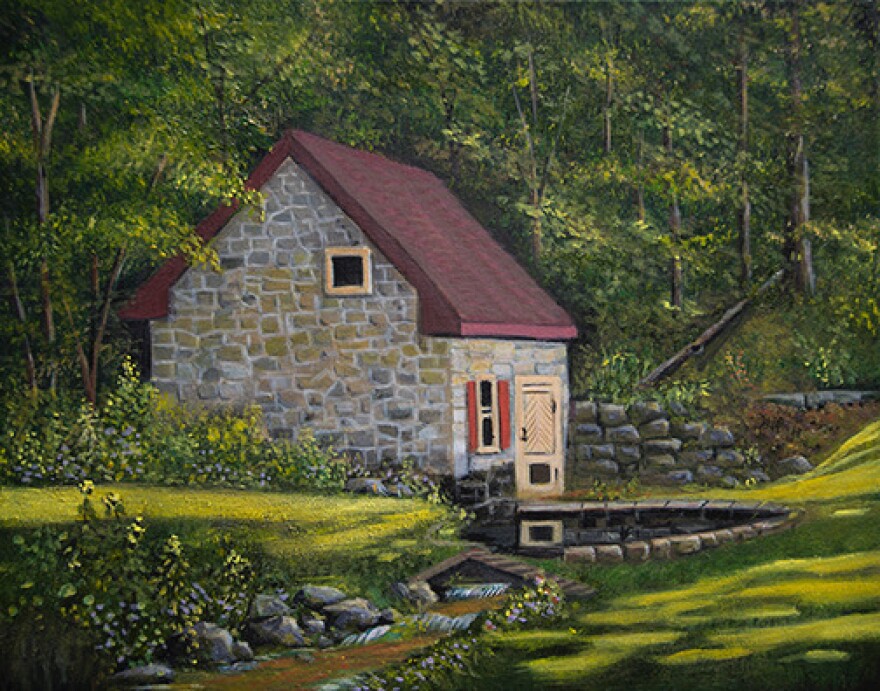ALLENTOWN, Pa. — In his studio filled with canvases, brushes and acrylic paints, photographer Hub Willson sets up to paint another portrait inspired by his travels.
In the background, music plays — a mash-up as diverse as the Brandywine Concertos to pop tunes by Lehigh Valley native Sabrina Carpenter, now a Grammy award-winning chart-topper.
"I did Sabrina Carpenter's headshots when she lived here, so I got into her music, her early stuff mostly," Willson said of the "Espresso" singer.
"I still keep in touch with her sister and mom occasionally."
Willson, who has called the art studio/gallery adjacent to Dan's Camera City a second home for 30 years, will close in June.
Starting Friday, Willson and his wife, Donna, will hold "one last hurrah," where many of his paintings — around 800 in total — will be on sale for $75 each.
The gallery sale will be open from 4 to 7 p.m. Friday, May 2, noon to 5 p.m. Saturday, May 3, and noon to 5 p.m. Sunday, May 4.
Locally, Willson is as well known for using his camera to capture images of performers mid-song, sweaty and onstage, for the past 40 years.
To name a few: Ray Charles, Little Richard and Pete Seeger during their respective concerts at Musikfest (he was the lead photographer since the festival's 1984 inception), and also at Celtic Classic and Mayfair Festival of the Arts.
Willson also is a musician, having started playing the drums and keyboard as a teen.
He later joined The Limits, a top Lehigh Valley local garage band known for hits "He'll Make You Cry," "Rachel," and "Haven't You Heard."
Willson also has made solo recordings, which are available to stream on Amazon and Spotify.
Art therapy
Of all his artistic endeavors, Willson said it is painting that is the most therapeutic.
He began some 40 years ago, inspired by performers he shot in various positions and poses at venues such as Allentown's historic Civic Theatre, the Lehigh Valley Reportary Dance Theatre and the Pennsylvania Youth Theatre.
"I would photograph the people, cut them out, and put them into my paintings, and call those paintographs, because they were a combination of painting and photographs."Hub Willson
He dubbed that first collection "paintographs."
"I would photograph a lot of ballet dancers during these very periods, and I wanted to look more painterly, so I would paint backgrounds that were sort of just like a little open field with a nice sky or distant mountains," he said.
"Then I would photograph the people, cut them out, and put them into my paintings, and call those paintographs, because they were a combination of painting and photographs."
Later, Willson began to experiment with seasonal landscape portraits.
"It was mostly plain air — so spring, summer, fall," Willson said. "I paint outside as much as I can, so I'm in the parks a lot. I often paint by the Bogert covered bridge in the parkway near my house.
"I also try to capture the historic buildings in the area. My older stuff consists of a lot of log cabins, covered bridges.
'I never had a painting course, so I'm self-taught on painting, and I've done one a day pretty much every day for the last 13 years."
Inspired by Turner
Willson, who majored in graphic design and fine art advertising at Kutztown University, said his career as a photographer has helped his painting — specifically with compositions and color lighting.
"I love back lighting and atmospheric lighting, so all that composition and color knowledge goes right into the painting," he said.
"A lot of my stuff is very atmospheric. My favorite style is tonal, which is a minimal palette and in the sunset, very often."
Willson compares his style to that of English painter J. M. W. Turner, who created art using expressive coloring and imaginative landscapes.
"Everything I paint is a place I wish I could be."Hub Willson
"Everything I paint is a place I wish I could be," Willson said. "The average painting I usually do in one sitting, because I'm painting with acrylics instead of oils.
"I like to layer the painting, and if you're painting outside on a breezy day, your paint dries almost before you get it to the canvas.
"I can do multi layers of painting, and everything dries before I put it back in the car. I like that personally. I guess that's why I'm so prolific. I can just get a lot done in a short time."

Traveling the world
When he's not drawing from scenes in the Lehigh Valley, Willson conjures up memories from trips overseas.
In the 1970s, Willson worked as a photographer/illustrator for the Summer Institute of Linguistics in New Guinea.

"New Guinea is as far as you can get from here," Willson said. "It doesn't matter which direction you go to get there, it's the same distance.
"So I went west through Honolulu, through Japan to Australia, and then into New Guinea. On the way home, I went to Singapore, Saudi Arabia, Rome, Frankfurt, Amsterdam, London, and then back to Philadelphia."
A couple of summers ago, Willson and his family visited Glacier National Park in Montana and Yosemite National Park in California, which also led to several landscape portraits.
Tracing Irish roots
After the studio closes for good, Willson said, he will celebrate his retirement with a family trip to the Emerald Isle.
"Thirty-two members of my immediate family are going to Ireland," he said. "They have all Irish backgrounds, and we rented a lodge that sleeps all of us, and we have the entire place to ourselves on the West Coast.
"Then I'd like to travel to the Great Lakes, Virginia and Kentucky."
On those adventures, he said, he'll take his trusty cameras along and shoot as much as possible.

And yes, some of those photos will eventually be turned into more paintographs.
Weather permitting, Willson said, he'll continue to set up his easel and supplies near the Bogert Covered Bridge at Lehigh Parkway and 24th Street.
Stop by and say hello, he said.
"About a third of the people will just walk by and not even turn their heads while I'm painting," Willson said. "Another third will start a conversation, and then about 2 percent will buy a painting.
"I've sold about 500 paintings, so I have a lot more to go."
For information and directions to the gallery, visit Willson's website.


